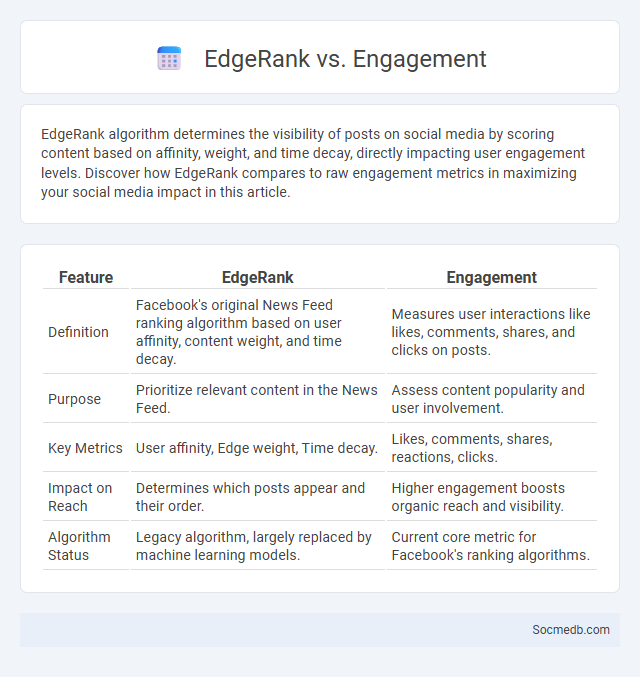
Photo illustration: EdgeRank vs Engagement
EdgeRank algorithm determines the visibility of posts on social media by scoring content based on affinity, weight, and time decay, directly impacting user engagement levels. Discover how EdgeRank compares to raw engagement metrics in maximizing your social media impact in this article.
Table of Comparison
| Feature | EdgeRank | Engagement |
|---|---|---|
| Definition | Facebook's original News Feed ranking algorithm based on user affinity, content weight, and time decay. | Measures user interactions like likes, comments, shares, and clicks on posts. |
| Purpose | Prioritize relevant content in the News Feed. | Assess content popularity and user involvement. |
| Key Metrics | User affinity, Edge weight, Time decay. | Likes, comments, shares, reactions, clicks. |
| Impact on Reach | Determines which posts appear and their order. | Higher engagement boosts organic reach and visibility. |
| Algorithm Status | Legacy algorithm, largely replaced by machine learning models. | Current core metric for Facebook's ranking algorithms. |
Introduction to EdgeRank and Engagement
EdgeRank is Facebook's algorithm that determines the visibility of posts in users' News Feeds by analyzing factors such as user affinity, content weight, and time decay. Your engagement, including likes, comments, and shares, directly influences EdgeRank by signaling content relevance and encouraging broader distribution. Understanding EdgeRank helps optimize social media strategies to increase reach and foster meaningful interactions.
What is EdgeRank?
EdgeRank is the algorithm Facebook uses to determine which posts appear in a user's news feed, optimizing content visibility based on user engagement. It evaluates three key factors: affinity (the relationship between the user and content creator), edge weight (the type of interaction, such as likes, comments, or shares), and time decay (the recency of the content). Understanding EdgeRank helps businesses and marketers increase their reach by tailoring posts to boost engagement and relevance.
Understanding Facebook Engagement
Facebook engagement metrics, including likes, comments, shares, and reaction emojis, provide critical insights into audience interaction and content relevance. Tracking these key performance indicators helps you analyze user behavior and optimize your posting strategy to increase reach and community involvement. Leveraging Facebook Insights tools can enhance your understanding of engagement patterns, enabling data-driven decisions to boost your social media presence.
Differences Between EdgeRank and Engagement
EdgeRank is the algorithm Facebook uses to prioritize which posts appear in a user's newsfeed based on affinity, weight, and time decay, while engagement measures the direct interactions such as likes, comments, and shares on your posts. Your social media strategy should understand that EdgeRank influences the visibility of content, whereas engagement reflects the actual user involvement and interest. Maximizing both EdgeRank factors and engagement metrics enhances your content's reach and effectiveness on social platforms.
The Role of EdgeRank in Facebook’s Algorithm
EdgeRank is a key component of Facebook's algorithm that determines the visibility of posts in users' News Feeds by analyzing three main factors: user affinity, content weight, and time decay. User affinity measures the relationship strength between users and content creators, content weight evaluates the importance of different content types such as photos, videos, and status updates, and time decay prioritizes newer posts to keep feeds relevant. Understanding EdgeRank enables marketers and content creators to optimize engagement by targeting posts that resonate closely with their audience while maintaining timeliness.
How Engagement Impacts Your Posts
Higher engagement rates on social media significantly boost the visibility of your posts within platform algorithms, increasing reach and interaction. Metrics such as likes, comments, shares, and saves signal content quality and relevance, prompting platforms to prioritize your posts in followers' feeds. By fostering genuine interaction, you enhance brand awareness and build a loyal online community.
EdgeRank Factors: Affinity, Weight, and Decay
EdgeRank, Facebook's algorithm for prioritizing content, relies on three key factors: Affinity, Weight, and Decay. Affinity measures the relationship strength between users and content creators, influencing how likely content appears in a user's feed. Weight assigns value to different content types, such as photos or links, while Decay reduces the visibility of older posts over time, ensuring fresh content is prioritized.
Edgerank’s Evolution: From EdgeRank to Engagement Signals
Edgerank's evolution from a simple algorithm prioritizing user-content relevance to the complex system of engagement signals reflects Facebook's adaptation to user behavior and content diversity. The original EdgeRank prioritized affinity, weight, and time decay, while current engagement signals incorporate likes, comments, shares, and video views to tailor news feed visibility. This shift enhances user experience by promoting meaningful interactions and personalized content discovery on the platform.
Strategies to Improve Both EdgeRank and Engagement
Optimizing EdgeRank involves prioritizing high-quality content, consistent posting schedules, and enhanced user interactions such as likes, comments, and shares to increase visibility. Utilizing targeted hashtags, responding promptly to audience engagement, and leveraging platform-specific features like Stories or live videos boost organic reach and foster deeper connections. Monitoring analytics to refine content strategies and incorporating user-generated content further amplify engagement metrics and algorithmic favorability.
Conclusion: Which Matters More—EdgeRank or Engagement?
Engagement holds greater significance than EdgeRank as it directly reflects how users interact with content, driving organic reach and fostering community growth. While EdgeRank algorithms influence visibility, high engagement signals relevancy and quality to social media platforms, boosting overall performance. Prioritizing authentic interactions and meaningful content generates sustained engagement that ultimately shapes social media success.
 socmedb.com
socmedb.com